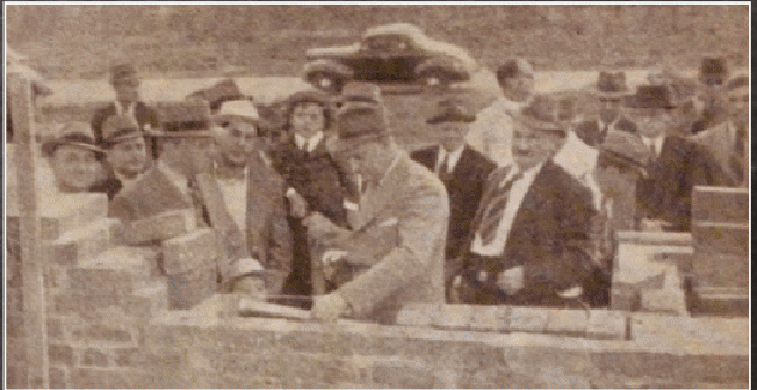
Community

Secret history buried in shul foundations around the world
When the Small Jewish Communities Association of South Africa’s Rabbi Moshe Silberhaft found a glass time capsule hidden behind the foundation stone of the Rustenburg Shul, it triggered an outpouring of interest from around the globe.
It turned out that Silberhaft has discovered many such time capsules in his role as travelling rabbi. Not only that, but time capsules have been discovered hidden behind foundation stones in synagogues around the world.
According to research published by The University of Victoria (British Columbia, Canada), “Cornerstones often contain a cavity in which a time capsule or ‘votive deposit’ could be placed. Historically, local newspapers, coins in circulation, and other artefacts relevant to the time were placed within the vessel. Today, most vessels are to be opened on a given date. Traditionally, vessels were deposited in the hope that they would never be disturbed.”
It seems this was a custom all over the world. “Among the synagogues built in the Copperbelt region [Zambia] was one in Mufulira, the smallest and northernmost of the places where Jews established themselves. Their synagogue in the Mufulira central district was built on a generous plot of land acquired by the community in about 1945, and construction began that same year. An early construction ceremony was held by the congregation when it deposited some type of time capsule in one of the incomplete walls.” This is according to a website titled “Sub-Saharan Africa synagogues – architecture and context”.
Silberhaft shares an incredible tale about this time capsule. “The Mufulira shul was sold in the 1970s to a church. When I started to travel there in the late 1990s, I used to visit the old synagogue and communal buildings. There, the priest asked me, ‘Do you Jews bury people in the synagogue or under the synagogue?’ I said, ‘No, we don’t do that.’ He said, ‘Well, when we worship, we still feel a Jewish presence in the synagogue, and it’s unsettling for us.’
“On my return to South Africa, I contacted Barry Epstein who was involved in building the shul at the time,” says Silberhaft. “He said, ‘We did bury a copper time capsule in the walls in 1948. There was no foundation stone, it was just buried in the walls.’ I asked him to tell me where it was. He drew a picture: four bricks up, four bricks to the right, on a corner. He also gave me a picture of him and others putting this time capsule into the wall.
“On my next visit to Mufulira, I had a builder with me as well as a chisel and a hammer. We found the sealed copper time capsule. It had in it the newspaper of the day, a few coins of the time, and the list of the executive committee that established the shul. We took the capsule, sealed up the wall, and painted it. Now, every time I visit the church [or former shul], the priest blesses me, because he says they can now worship in peace.”
Meanwhile, in Sydney, Australia, on 26 January 1875, Sydney’s Jewish community gathered to celebrate the laying of the foundation stone of the iconic Great Synagogue, and buried a time capsule there.
In England, as described in The Jewish News and the Jewish Chronicle, builders discovered a 150-year-old time capsule at the Manchester Jewish Museum during renovation work in September 2020, just before the high holidays. A year later, the capsule went on display for the first time at the Manchester Jewish Museum. Its contents remain a mystery.
It had been buried deep in a wall cavity near to the synagogue’s ark, dated to the building’s foundation in 1873. The wax-sealed capsule, which is filled with papers, coins, and synagogue documents, is now on display. Officials at the museum say they are working with paper conservators to safely open the capsule this year.
These items are similar to what has been found in other synagogue time capsules. In Washington, DC, the building on the corner of 6th and I Streets has undergone numerous incarnations, and is currently the world renowned Sixth & I Historic Synagogue. The shul’s website says that the congregation held a cornerstone laying ceremony on 22 November 1906.
It placed a time capsule inside the cornerstone containing copies of Jewish newspapers, coins minted in 1906, congregation membership lists, copies of constitutions, and a copy of the 15 April 1865 edition of the New York Herald, which included articles on the assassination of President Abraham Lincoln.
Also in America, according to The Forward, deteriorating documents, newspapers, and coins were unearthed at the Jewish History Museum in Tucson, which once served as Arizona’s first synagogue. The items were found in 2010 in a time capsule buried inside a cornerstone of the building 100 years ago. At a celebration to mark the shul’s 100th anniversary, a 2010 time capsule was placed in the ground filled with, among other things, 2010 US coins, local newspapers, and an American flag that was carried in Tucson in 1912, to be opened 100 years from then.
Also in the US, in Richmond, Virginia, the façade of Congregation Beth Ahabah’s Barbara and William B. Thalhimer, Jr. Religious School was demolished in 2017 to facilitate construction of its new integrated campus. Contractors and staff were surprised to discover a time capsule hidden behind the cornerstone. The time capsule, a soldered copper box, had been concealed for 62 years since a cornerstone laying ceremony on 2 June 1957.
On 7 June 2019 at the end of the Shabbat service, community member Billy Thalhimer III and Rabbi Scott Nagel opened the capsule. The contents included a photograph of the 1957 cornerstone laying ceremony featuring a young Billy Thalhimer III. A new time capsule was sealed by the congregation, to be opened in 2069.
One of the most poignant time capsules discovered in recent times is one placed by congregants of the Tree of Life Synagogue in Pittsburgh. The same congregation would endure a massacre when on 27 October 2018, a gunman attacked the synagogue, killing 11 people.
One hundred and thirteen years ago, members of the congregation placed documents, religious items, and even a Heinz pickle pin in the cornerstone of its original synagogue in Pittsburgh’s Oakland neighbourhood when it was built in 1906. In 1953, the congregation moved out of that building to its location in the Squirrel Hill neighbourhood. On 4 November 2019, Tree of Life officials and long-time congregants opened the time capsule found inside the cornerstone at the old site of their shul.
According to the Jewish News of Northern California, when the 1895 cornerstone of San Francisco’s historic Congregation Ohabai Shalome was removed in October 2001, local Jewish history buff Felix Warburg was waiting in anticipation.
The cornerstone of the disbanded synagogue contained a time capsule with items dating back to the Lincoln assassination and the pre-gold-rush era. Among them were American and Chinese coins, Anglo-Jewish publications, a mezuzah, and a 1847 letter in Yiddish that was sent from Hamburg, Germany, to someone in Mississippi.
“I was absolutely amazed,” said Warburg, a San Francisco architect. “I always expected that there would be a time capsule, but what was a real surprise was how much older some of the documents were.”
Warburg’s knowledge that the synagogue’s cornerstone would contain a time capsule was based on prior experience. When the cornerstone of another nearby shul was extracted some years before, it also held a time capsule.
There are probably many more “messages in a bottle” waiting to be uncovered around the globe. “We should always be aware that history is all around us waiting to be uncovered,” said Warburg. “It’s like a puzzle with an unknown number of pieces. We don’t know where the next one will come from or how many there are, but it’s important for people to know their history and that of their community.”










